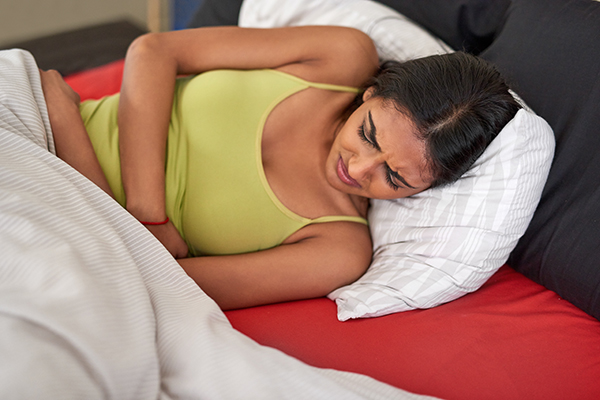Pubertal Menorrhagia
- Symptoms, Causes, Prevention & Homeopathic treatment
Pubertal menorrhagia refers to heavy and prolonged menstrual bleeding that occurs in adolescent females around the time of their first period (menarche). While irregularities in menstrual cycles are common during puberty, excessive and prolonged bleeding can be concerning and may impact a young girl’s physical and emotional well-being. As understanding pubertal menorrhagia is crucial for managing symptoms effectively and addressing any underlying issues that may be contributing to the condition. In this article we aim to shed light on the causes, symptoms, investigations, and the potential benefits of homeopathy in managing pubertal menorrhagia, ultimately enhancing the quality of life for affected individuals.

Symptoms of Menorrhagia
- Heavy Menstrual Flow: Excessive bleeding that requires frequent changing of menstrual products, or blood loss that is significantly greater than what is typical for the individual.
- Prolonged Bleeding: Menstrual periods lasting longer than usual, often extending beyond seven days.
- Passing Large Blood Clots: Clots larger than a coin may be present in menstrual flow.
- Severe Cramps: Intense abdominal cramps or pelvic pain during menstruation.
- Fatigue: Persistent tiredness or weakness due to significant blood loss.
- Anemia Symptoms: Signs such as dizziness, shortness of breath, and pale skin related to reduced red blood cell count.
- Interference with Daily Activities: The severity of bleeding may interfere with regular activities.
When to See a Doctor
Consult a healthcare provider if you experience:
- Excessive Bleeding: Bleeding that is unusually heavy or does not improve with menstrual products.
- Persistent Symptoms: Prolonged or recurring symptoms despite treatment or lifestyle changes.
- Anemia Symptoms: Symptoms of anemia such as fatigue, dizziness, or shortness of breath.
- Disruption of Daily Life: Symptoms that interfere with school, social activities, or daily functioning.
Causes of Menorrhagia
Pubertal menorrhagia can be caused by various factors, including:
- Hormonal Imbalances: Disruptions in the balance of estrogen and progesterone during puberty can lead to irregular and heavy bleeding. Fluctuations in hormone levels during puberty leads to an irregular shedding of the uterine lining, resulting in menorrhagia.
- Immaturity of the Reproductive System: An underdeveloped endometrial lining that may not shed properly, causing prolonged bleeding.
- Coagulation Disorders: Blood clotting disorders can contribute to prolonged and heavy menstrual bleeding. Conditions such as von Willebrand disease or platelet disorders that affect blood clotting.
- Reproductive Disorders: Conditions like polycystic ovary syndrome (PCOS) or uterine fibroids. Structural issues within the uterus, such as fibroids or polyps, may lead to menorrhagia.
- Thyroid Disorders: Imbalances in thyroid hormone levels that can impact menstrual cycles.
Risk Factors
Several factors may increase the risk of pubertal menorrhagia:
- Age: Adolescents who have recently started menstruating are more likely to experience irregularities in their cycles.
- Family History: A family history of menstrual disorders or bleeding disorders.
- Chronic Conditions: Presence of chronic health conditions such as thyroid disorders or bleeding disorders.
- Stress: High levels of emotional or physical stress can impact menstrual regularity and bleeding patterns.
Complications
Pubertal menorrhagia can lead to several complications:
- Anemia: Significant blood loss can result in anemia, characterized by low red blood cell count and associated symptoms like fatigue and dizziness.
- Impact on Growth and Development: Chronic blood loss may affect growth and overall physical development in adolescents.
- Psychological Impact: Emotional stress, embarrassment, or social isolation due to symptoms can affect mental well-being.
- Disruption of Daily Life: Impact on academic performance, social activities, and overall quality of life.
Preventions
Preventive measures and management strategies can help address and reduce the impact of pubertal menorrhagia:
- Healthy Diet: A balanced diet rich in iron, vitamins, and minerals to support overall health and mitigate anemia.
- Regular Exercise: Engage in moderate physical activity to promote overall well-being and manage stress.
- Stress Management: Techniques such as relaxation exercises, yoga, or counseling to manage stress and emotional health.
- Routine Medical Check-Ups: Regular gynecological exams and blood tests to monitor health and detect any underlying conditions early.
Homeopathic medicine for Heavy Menstrual Bleeding
Homeopathy offers a personalized approach to managing pubertal menorrhagia by addressing both physical symptoms and underlying imbalances. HealthKunj Clinics offer a safe and non-invasive approach to managing pubertal menorrhagia. By addressing the root cause and promoting the body’s self-healing mechanisms, A homeopathic practitioner can provide tailored remedies and treatment plans based on individual symptoms and overall health.
Diagnosis
Diagnosing pubertal menorrhagia involves:
- Medical History: Reviewing menstrual history, symptoms, and overall health.
- Physical Examination: A gynecological exam to assess menstrual patterns and any physical abnormalities.
- Laboratory Tests: Blood tests to evaluate hormone levels, check for anemia, and screen for coagulation disorders.
- Imaging Studies: Pelvic ultrasound or other imaging techniques to identify structural abnormalities or reproductive disorders.
When an adolescent presents with pubertal menorrhagia, a thorough evaluation is essential to determine the underlying cause.
Treatments
Treatment for pubertal menorrhagia may include:
- Medications: Hormonal treatments such as birth control pills or progesterone to regulate menstrual cycles and reduce bleeding.
- Iron Supplements: To address or prevent anemia due to significant blood loss.
- Addressing Underlying Conditions: Treatment of any underlying health issues such as thyroid disorders or bleeding disorders.
- Lifestyle Modifications: Adjustments in diet and exercise to support overall health and manage symptoms.
Lifestyle and Home Remedies
In addition to medical treatments, lifestyle changes and home remedies can support symptom management:
- Healthy Eating: Incorporate iron-rich foods such as leafy greens, red meat, and legumes to support blood health.
- Regular Physical Activity: Engage in moderate exercise to promote overall health and manage stress.
- Hydration: Drink plenty of water to support general health and help manage symptoms like bloating.
- Herbal Remedies: Herbal teas such as nettle or red clover may support menstrual health and reduce bleeding.
Beyond managing the physical symptoms, homeopathy takes into account the emotional and mental well-being of the young patient. By promoting overall health and restoring balance, homeopathy can significantly enhance the quality of life for adolescents experiencing pubertal menorrhagia. Homeopathic remedies are safe, non-toxic, and do not interfere with other medications or hormonal therapies. It is essential for adolescents with pubertal menorrhagia to consult a qualified homeopathic physician for personalized and comprehensive care.
Preparing for Your Appointment
To make the most of your appointment with a healthcare provider or homeopathic practitioner, consider:
- Document Symptoms: Keep a detailed record of menstrual symptoms, including their onset, frequency, and impact on daily life.
- List Medications and Supplements: Bring information about any current medications or supplements you are taking.
- Prepare Questions: Write down any questions or concerns you have about your symptoms, treatment options, and overall health.
- Health History: Provide a comprehensive overview of your health history, including any existing conditions and family history of menstrual or bleeding disorders.
Pubertal menorrhagia can be distressing for young females during a significant transitional period in their lives. With the gentle and individualized approach of homeopathy, symptoms can be effectively managed, leading to improved menstrual health and enhanced overall well-being.
